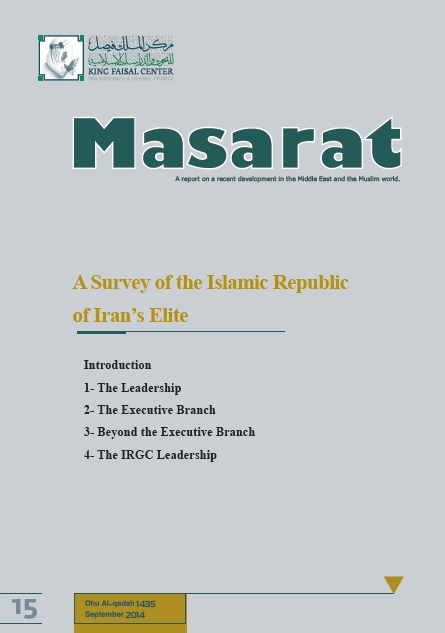A Survey of the Islamic Republic of Iran’s Elite
Issue 15. September 2014 (Dhu Al-qadah 1435 H.)
Abstract:
One of the defining features of the present-day Islamic Republic of Iran is the unique nature of its political class. “Political class” here is taken to mean the segment of society which holds incumbency in state institutions, according to the definitions of Gaetano Mosca and others. The Islamic Republic’s ruling elite is at once restricted and diverse. It encompasses a complex mix of pious laity and Shi’ite clergy of various levels and prominence. It also lacks some of the basic elements of other modern political elite classes, such as structured and well-defined parties. The Iranian political class seeks to substitute its lack of political parties with the alternative model of “factions,” loosely organized congregations of figures who hold common views on key themes, such as foreign and defense policy or social management. This characterization, popularized by the analyses of international media and prominent academic and think-tank studies, is too broad to be truly accurate. While factions do exist within the Iranian system, they are amorphous, lack discipline, and find themselves splintered at times of major divisions within the elite, such as the period following the contested 2009 elections. It is more useful to note that the Islamic Republic’s elite is structured along clannish lines, with influential figures scattered across the various institutions. These figures create loose and flexible groups of supporters and followers, who in turn rely upon their patrons for access to political positions, privilege, and a durable presence within the upper rungs of state institutions. By and large, the most prominent political figure in this configuration of the state is Ayatollah Ali Khamenei, the Supreme Leader. However, it should be noted that the atomised and informal mechanisms which govern the state system, and which have roots in traditional forms of interaction within Iranian society, also gravitate against attempts to impose a more rigid authoritarian system and effectively ward off dictatorship through a complex mechanism of bargaining and negotiation. In order to understand how Iran’s political class works, it is crucial to examine the processes which grant entry into the political elite.The lack of structured political organizations, or parties, makes the “card-carrying” method common to many party-based systems, whether democratic or not, irrelevant to political prominence. This is important, as it has led to figures having a lower standing within the elite, such as Mahmoud Ahmadinejad, gaining incumbency in high political office without being endorsed as a consensus candidate or becoming a leader of a major political organization. A complex web of interpersonal relations forms the basis of the Islamic Republic’s political elite. The following presents the main protagonists of the current elite of the Islamic Republic through a scheme which looks at their positioning within the various branches of state.

